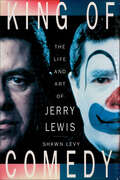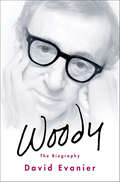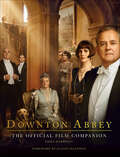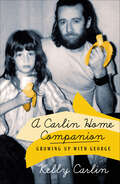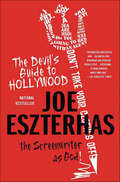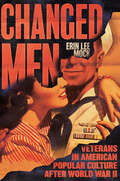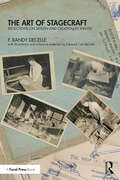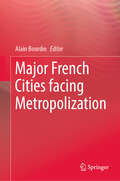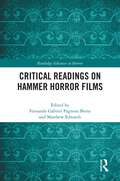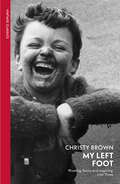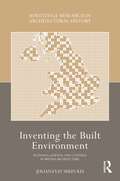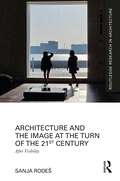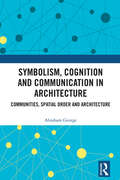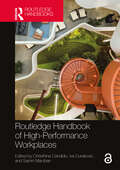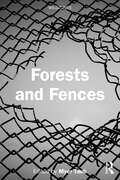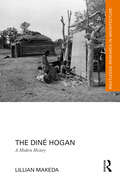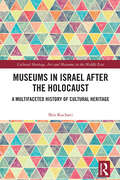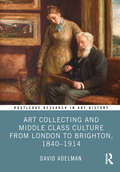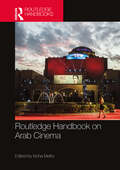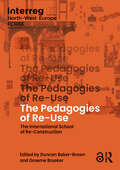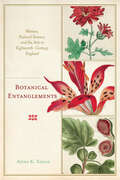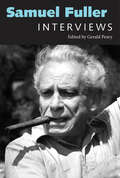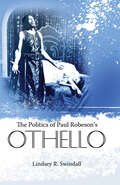- Table View
- List View
King of Comedy: The Life and Art of Jerry Lewis
by Shawn LevyShawn Levy's fascinating biography King of Comedy - the product of vast research and interviews with contemporaries, admirers, foes, and even, briefly, Lewis himself - traces the story of a man who defines High American Show Biz. At points along the time line of his career, Lewis has been the highest-paid performer in history in film, on television, and (in 1995!) on Broadway. With partner Dean Martin, he was half of the most successful comedy duo of all time. He was the first director who debuted in talkies to direct himself. He was a direct, acknowledged influence on giants from Woody Allen to Lenny Bruce to David Letterman to Jim Carrey. He is a Chevalier of the French Legion of Honor, has raised over $1 billion in charity, and was once nominated for a Nobel Peace Prize. And, since the 1950s, he has been one of the most recognized faces on earth. For almost that long, though, people have argued over what Jerry Lewis means. Is he a talented comedian or a grotesque mimic? A startlingly original director or a pretender to Chaplin's throne? A multifaceted entertainer or a megalomaniacal egoist? A tireless champion of the disabled or a tireless self-promoter who has confused America's charitable impulses with affection for him as a performer?
Woody: The Biography
by David EvanierIn this first biography of Woody Allen in over a decade, David Evanier discusses key movies, plays and prose as well as Allen's personal life. Evanier tackles the themes that Allen has spent a lifetime sorting through in art: morality, sexuality, Judaism, the eternal struggle of head and heart. Woody will be the definitive word on a major American talent as he begins his ninth decade, and his sixth decade of making movies.
Extraordinary Dogs: Stories from Search and Rescue Dogs, Comfort Dogs, and Other Canine Heroes
by John Schlimm Liz StavrinidesA beautiful photo book showcasing more than 50 heroic dogs "in uniform" and their stories, from photographer Liz Stavrinides and author John Schlimm. Extraordinary Dogs portrays more than fifty working dogs, along with the police officers, firefighters, veterans, and other trained volunteer handlers who serve side-by-side with them. Their moving stories and beautiful photographs are an unprecedented glimpse at Comfort Dogs and Search and Rescue Dogs, along with bomb-detecting TSA dogs and canine ambassadors from across the United States.* The stories of the Lutheran Church Charities K-9 Comfort Dogs take readers behind the scenes of their headlining deployments—such as the Boston Marathon bombing, Superstorm Sandy, and the mass shooting at Marjory Stoneman Douglas High School.* Search and Rescue K-9 teams reveal what it’s really like to travel into the eye of natural disasters, accidents, crime scenes, and the worst terrorist strike in recorded history. * At Washington Dulles International Airport, readers meet several of the Department of Homeland Security’s TSA dogs whose sole job it is to keep the flying public safe from explosives and other dangers.Extraordinary Dogs is both a portrait of what love, hope, courage, and heroism look like in their purest forms and a tribute to the eternal and impactful bonds we forge with our furry friends.
Downton Abbey: The Official Film Companion
by Emma MarriottThe official tie-in book for Downton Abbey, the full-length feature film.Downton Abbey: The Official Film Companion is a stunning memento, bringing the world and the characters of our favorite fictional country house to life. Featuring spectacular photographs from the production, interviews with the cast and crew, and a look into the historical and geographical backdrop of the film, this official guide to the Downton Abbey film is made to be treasured and loved by fans across the globe.The film revolves around the King and Queen making an official visit to Downton in 1927, and not only sees the return of all the main cast from the final television series, but also introduces some great British actors to the world of Downton, as we meet the royal family and their retinue. The accompanying book is lavishly illustrated with stunning shots from both behind and in front of the camera, which capture some wonderful off-guard moments during filming, as well as the original costume illustrations.
A Carlin Home Companion: Growing Up with George
by Kelly CarlinFrom the daughter of the iconoclastic comedic performer, Kelly Carlin’s memoir A Carlin Home Companion: Growing Up with George “is written in the DNA of a Carlin, honest, biting, savage, funny, sad, dark, and profound…Hold on; like George Carlin, this book gives you a hell of a ride” (New York Times bestselling author and multi-award-winning comedian Lewis Black).Truly the voice of a generation, George Carlin gave the world some of the most hysterical and iconic comedy routines of the last fifty years. From the “Seven Dirty Words” and “A Place for My Stuff”, to “Religion is Bullshit” and “The American Dream”, he perfected the art of making audiences double over with laughter while simultaneously making people wake up to the realities (and insanities) of life in the twentieth century.Few people glimpsed the inner life of this beloved comedian, but his only child, Kelly, was there to see it all. Born at the very beginning of his decades-long career in comedy, she slid around the “old Dodge Dart,” as he and wife Brenda drove around the country to “hell gigs.” She witnessed his transformation in the ’70s, as he fought back against—and talked back to—the establishment; she even talked him down from a really bad acid trip a time or two (“Kelly, the sun has exploded and we have eight, no-seven and a half minutes to live!”).Kelly not only watched her father constantly reinvent himself and his comedy, but also had a front row seat to the roller coaster turmoil of her family’s inner life—alcoholism, cocaine addiction, life-threatening health scares, and a crushing debt to the IRS. But having been the only “adult” in her family prepared her little for the task of her own adulthood. All the while, Kelly sought to define her own voice as she separated from the shadow of her father’s genius.With rich humor and deep insight, Kelly Carlin pulls back the curtain on what it was like to grow up as the daughter of one of the most recognizable comedians of our time, and become a woman in her own right. This vivid, hilarious, heartbreaking story is at once singular and universal—it is a contemplation of what it takes to move beyond the legacy of childhood, and forge a life of your own.
The Devil's Guide to Hollywood: The Screenwriter as God!
by Joe EszterhasIn The Devil's Guide to Hollywood, bestselling author and legendary bad-boy screenwriter Joe Eszterhas tells everything he knows about the industry, its players and screenwriting itself—from the first blank sheet of paper in the Olivetti to the size of the credit on the one-sheet. "There's just one hunk of funny anecdote after another, quotes from everyone who ever mattered in the movie biz, and the thing is jam-packed with screenwriterly advice. Plus it's hilariously funny, ribald, sexy and brilliant."—Liz SmithOften practical and always entertaining, The Devil's Guide to Hollywood distills everything one of Hollywood's most accomplished screenwriters knows about the business, from writing advice to negotiation tricks, from the wisdom of past players to the feuds of current ones. Eszterhas has selected his personal pantheon of the most loved and loathed players in the business and treats the reader to a treasure trove of stories, quotes and wisdom from those luminaries, who include William Goldman (loathes) and Zsa Zsa Gabor (loves). The Devil's Guide to Hollywood could only have been written by someone who loves the business as much as Eszterhas does—but who also has its number."Eszterhas delivers a dishy, catty mix of reminiscences and Hollywood trivia…his forte is skewering sycophants and phonies in this opinionated showcase of the underside of Hollywood life."—Publishers Weekly
Changed Men: Veterans in American Popular Culture after World War II (Cultural Frames, Framing Culture)
by Erin Lee MockPostwar culture and anxiety over the reintegration of veterans into American society Millions of GIs returned from overseas in 1945. A generation of men who had left their families and had learned to kill and to quickly dispatch sexual urges were rapidly reintegrated into civilian life, told to put the war behind them with cheer and confidence. Many veterans struggled, openly or privately, with this transition. Others in society wondered what the war had wrought in them. As Erin Lee Mock shows in this insightful book, the &“explosive&” potential of men became a central concern of postwar American culture. This wariness of veterans settled into a generalized anxiety over men&’s &“inherent&” violence and hypersexuality, which increasingly came to define masculinity. Changed Men engages with studies of film, media, literature, and gender and sexuality to advance a new perspective on the artistic and cultural output of and about the &“Greatest Generation,&” arguing that depictions of men&’s violent and erotic potential emerged differently in different forms and genres but nonetheless permeated American culture in these years. Viewing this homecoming through the lenses of war and trauma, classical Hollywood, pulp fiction, periodical culture, and early television, Mock shows this history in a provocative new light.
The Art of Stagecraft: Reflections on Design and Creation in Theatre
by F. Randy deCelleThe Art of Stagecraft: Reflections on Design and Creation in Theatre is a thoughtful examination of the intersection of design, art, and the modern and contemporary theatrical design practitioner.Utilizing a recently discovered folio of materials of stagecraft practices that was being compiled by Mobile, Alabama artist Edmond Carl deCelle, who was nationally known for his sketches, paintings, murals, Mardi Gras pageants and parades, and theatre productions along the Gulf Coast in the years 1930–1970, the book examines methodologies of production using sketches from the artist as well as his thoughts on design, art, and the shifts that were happening in the industry during the time. The book looks at a sampling of traditional theatrical design and stagecraft practices that became formalized in the mid-20th century and compares them to contemporary practices, offering a reflection on the current state of theatre production, stagecraft practices, and the theatre practitioner as an artist.For those just coming into theatre production, The Art of Stagecraft provides a resource for a selection of well-proven, straightforward techniques that have been developed over many years. For those in theatre production, the book serves as a guide for an assortment of traditional techniques that are still in use today but may not be known by everyone. For all readers, this book will also look at a sample of traditional techniques that have been phased out in favor of contemporary methods due to the development of modern materials.
Major French Cities facing Metropolization
by Alain BourdinThis book characterizes a type of city, i.e. the metropolis, by using characteristics which have very little to do with its size. It distinguishes between metropolises and megacities and defines these different characteristics by bringing together elements related to facilities, accessibility and economic power on one hand and other elements which relate more to the capacity for innovation and, more generally, to the knowledge society and economy. All of which demonstrate the process of metropolization, as well as elements of daily life and, more generally, elements which relate to the urban experience. To live in a metropolis is not only to benefit from more urban amenities, but also to live in a different way, in particular, in a world which is much more diverse in every respect. Based on a series of metropolization criteria constructed and discussed, this book goes beyond ordinary statistical approaches to integrate the interterritorial scale of metropolitan systems as well as their qualitative dimension. Following in Simmel's footsteps, it shows that a city is also an atmosphere, a mentality, a spirit, all of which are poorly captured by statistical data. As such, the book focuses on five major themes: networks, economic development, social issues, urban form and the ecological and digital transition. The books makes an interesting read for urban planners, sociologists, planners and architects, and all specialists working in this field.
Critical Readings on Hammer Horror Films (Routledge Advances in Horror)
by Fernando Gabriel Pagnoni Berns Matthew EdwardsThis collection offers close readings on Hammer’s cycle of horror films, analysing key films and placing particular emphasis on the narratives and themes present in the works discussed.Ranging from the studio’s first horror outing, The Mystery of the Mary Celeste (1935) to Hammer’s last contemporary film, Doctor Jekyll (2023), the collection celebrates cult-favourites such as The Quatermass Experiment, the films of Terence Fisher, to overlooked classics such as Captain Clegg or The Mummy franchise. This volume also delves into Hammer’s psychological thrillers, the studio’s venture into TV with Hammer’s House of Horrors, with theoretical frameworks varying from queer studies to postcolonial readings.This volume will appeal to scholars and students of film studies, international cinema, film history and horror studies.
My Left Foot: The Life That Inspired My Left Foot
by Christy BrownChristy Brown was born a victim of cerebral palsy. But the hapless, lolling baby concealed the brilliantly imaginative and sensitive mind of a writer who would take his place among the giants of Irish literature. This is Christy Brown's own story. He recounts his childhood struggle to learn to read, write, paint and finally type, with the toe of his left foot. In this manner he wrote his bestseller Down all the Days.
Inventing the Built Environment: Planning, Science, and Control in British Architecture (Routledge Research in Architectural History)
by Juliana Yat KeiWhy and how was the term ‘built environment’ first introduced? Inventing the Built Environment retrieves the origin of this ubiquitous term. The articulation of the ‘built environment,’ Kei demonstrates, coincided with the redefinition of education, research, and professional practices in architecture and town planning in 1960s Britain.Concentrating on the half-decade during which the term permeated the architectural and planning professions, this book recalls a time when the ‘built environment’ was conceived as a part of the British government’s effort in national economic planning. Inventing the Built Environment unpacks the proposal for a Research Council for the Built Environment to mobilise architecture and town planning for political economy. How a relatively small group of architects, planners, politicians, and researchers transposed scientific thoughts from biology, economics, and computation into the ‘built environment’ will be considered, too. Kei highlights the assumptions about and classification of the population that were made when inventing the ‘built environment.’ The architectural and biosocial implications of the making and remaking of this architectural-environmental notion, in Britain and beyond, will be revealed through the works of pre-eminent architect-planners including Richard Llewelyn-Davies and William Holford.At a time when environmental concerns again take the front seat of architectural and planning debates, this book offers, for scholars and students, an alternative lens to reflect on the assumptions and bias that can be embedded in our architectural lexicons.
Architecture and the Image at the Turn of the 21st Century: After Visibility (Routledge Research in Architecture)
by Sanja RodešThis book examines architecture, image, and media relationships as productive for architecture and architectural discourses. By arguing that the relationships between architecture and media cannot be dismissed via linear criticism of architecture and media or image, these relations are instead seen as a part of a sphere (a mediasphere) of complex relationships. In lieu of anything like a consensus on the contemporary condition of architecture (referring to the late twentieth and the twenty-first centuries), the starting point of this book is that the relationships between architecture, media, and images continue to multiply, owing to continuous technological advancements.Contemporary architecture considered in this book is related to the selected circumstances of high visibility, where architectural images are propelled into visibility and conflated with non-architectural images. This takes architecture outside of architectural-only discourse and into the public realm. By granting higher visibility to both the architectural images and architecture in the public realm, architecture can also be influenced by the various perceptions of the general public and can enter public consciousness via non-architectural media. With increased visibility, architecture’s far-reaching presence calls for more structured analysis of its nature and potential. As the analysed architecture in this book is associated with the discourses outside of architecture (some of which relate to terrorism, natural disaster, and branding and consumption), the limits of contemporary architectural discipline are questioned and extended.This book is written for academics and students in architectural history, theory, and criticism, particularly those interested in visual and media studies.
Experiments in Art Research: How Do We Live Questions Through Art?
by Sarah Travis Jorge Lucero Azlan Guttenberg Smith Catalina Hernández-CabalExperiments in Art Research: How Do We Live Questions Through Art? is not a conventional research methods guide; it's an encounter for asking questions through art.Originating from the work of a community of tightly connected scholars, artists, and teachers, the book unfolds through a tapestry of moments, practices, and people, embracing the celebration of works in progress and in community. Rooted in the practice of permission-giving, the narrative intertwines personal stories—laying bare the transformative power of unconventional teaching methods, risky endeavors, and the breaking of scholarly norms—and begins by understanding that “art” and “research” are not separate. After that, there are endless directions to take up. Instead of a handbook offering rules or best practices, this text offers an inspiring collection of joy, longing, and determination. This is fascinating reading for arts-based researchers, artists, educators in the arts, education scholars, research-creators, performance theorists, art history scholars, art education scholars, inter- and anti-disciplinary scholars, qualitative and post-qualitative researchers, decolonization scholars, public humanities scholars, and writing pedagogy scholars.
Symbolism, Cognition and Communication in Architecture: Communities, Spatial Order and Architecture
by Abraham GeorgeThis book discusses the role and significance of symbols and symbolism in graphical communication toward the establishment of meaningful architecture. It explores how these are effectively applied in architectural education for the empowerment of learners in various cultures around the world. The volume examines the developments in graphic representations while recognizing the importance of cognition and its perception in spatial terms. In a scenario where architectural education is at crossroads, facing challenges of a global nature, this book highlights the importance of understanding architectural curriculum and design subjects. The author discusses the issues of communicating the knowledge of architecture to heterogeneous groups of students and explains how design fields and learning in architecture can be modified through cognitive instructional methods. The book outlines the methodology to develop symbols and symbolic pedagogical tools for effective communication in architecture. The book will appeal to students, researchers, teachers and scholars of architecture, design, planning and visual communication. It will also be of interest to architects, artists, spatial designers, town planners, urban planners and professionals.
Routledge Handbook of High-Performance Workplaces (Transdisciplinary Workplace Research and Management)
by Christhina Candido Iva Durakovic Samin MarzbanThis timely book focuses on an overview of the fundamentals behind high-performance workplaces underpinning occupants’ satisfaction, health, and productivity. To this end, it covers human, environmental, and organisational aspects proven to be of great relevance to the design of high-performance workplaces. Perhaps most significantly it looks at these characteristics both before and after the start of the COVID-19 pandemic. From the exodus from private offices to the rise of open-plan workplaces, where, how and when people work was changing rapidly pre-COVID. Post-COVID, pandemic-imposed restrictions banished workers from offices into their homes fast, leaving organisation scrambling to keep workers functioning away from HQ. After the immediate shockwaves set by the pandemic, workers and organisations have had the time to learn about positives and negative aspects of remote working with the vast majority now questioning the need to go back to HQ and the purpose of offices. In this book, the contributors share and discuss lessons learned from research conducted in workplaces pre- and post-2020 with a view of providing a clear picture about what high-performance workplaces are about, including the key drivers behind workers’ satisfaction, health, and productivity. This handbook builds on a programme of applied research conducted in workplaces led by the editors over the last decade which is aimed at understanding the synergies between the design, performance, and experience of spaces. It examines ergonomics, biophilic design, acoustics, indoor air quality, thermal comfort, diversity, leadership, psychological safety, culture, and much more. Research findings are presented side-by-side with case studies selected from the research database led by the editors. Industry experts add to the academic voice, reinforcing the authenticity of this book and its relevance to other stakeholders found outside the academic arena, including the property and design industry, students, government, and the community in general.The Open Access version of this book, available at http://www.taylorfrancis.com, has been made available under a Creative Commons Attribution-Non Commercial-No Derivatives (CC-BY-NC-ND) 4.0 license.
Forests and Fences (WildZones)
by Myer TaubThis book examines critical themes in environmental studies though theatre and performance studies. It experiments with forms along with the practice of praxis to provide radical frameworks for resilience in the contemporary age of crisis. Drawing on Ravi Sundaram’s concept of “Wild Zones”, it explores the kinetic overflows in informal sites, but also in the intimate spaces that have been realigned or shocked or fenced in, especially in the context of the COVID-19 pandemic.This volume will be of great interest to scholars and researchers of theatre and performance studies, environment and sustainability, and environmental humanities.
The Diné Hogan: A Modern History (Routledge Research in Architecture)
by Lillian MakedaOver the course of their history, the Navajo (Diné) have constructed many types of architecture, but during the 20th century, one building emerged to become a powerful and inspiring symbol of tribal culture. This book describes the rise of the octagonal stacked-log hogan as the most important architectural form among the Diné.The Navajo Nation is the largest Indian reservation in the United States and encompasses territory from within Arizona, New Mexico, and Utah, where thousands of Native American homes, called hogans, dot the landscape. Almost all of these buildings are octagonal. Whether built from plywood nailed onto a wood frame or with other kinds of timber construction, octagonal hogans derive from the stacked-log hogan, a form which came to prominence around the middle of the last century. The stacked-log hogan has also influenced public architecture, and virtually every Diné community on the reservation has a school, senior center, office building, or community center that intentionally evokes it. Although the octagon recurs as a theme across the Navajo reservation, the inventiveness of vernacular builders and professional architects alike has produced a wide range of octagonally inspired architecture. Previous publications about Navajo material culture have emphasized weaving and metalwork, overlooking the importance of the tribe’s built environment. But, populated by an array of octagonal public buildings and by the hogan – one of the few Indigenous dwellings still in use during the 21st century – the Navajo Nation maintains a deep connection with tradition. This book describes how the hogan has remained at the center of Diné society and become the basis for the most distinctive Native American landscape in the United States.The Diné Hogan: A Modern History will appeal to scholarly and educated readers interested in Native American history and American architecture. It is also well suited to a broad selection of college courses in American studies, cultural geography, Native American art, and Native American architecture.
Museums in Israel after the Holocaust: A Multifaceted History of Cultural Heritage (Cultural Heritage, Art and Museums in the Middle East)
by Shir Gal KochaviMuseums in Israel After the Holocaust explores the influence of the traumatic events of the Holocaust on the formation of a cultural heritage policy during the foundational years of the State of Israel.Based on primary research, the book offers a new understanding of cultural practices after the Second World War, while analyzing the role of key Jewish cultural representatives who shaped museum collections that emerged during this period. The book investigates the ways Israel has dealt with the complicated history of “heirless” Jewish cultural objects and questions of ownership, by providing a detailed examination of the process of allocation of “heirless” Jewish cultural property handled by two American-Jewish organizations: the Jewish Restitution Successor Organization (JRSO) and the Jewish Cultural Reconstruction (JCR) in the immediate years following the Second World War. The book takes a material culture approach, which explores the meanings and values attached to an object over the course of time and during its transition between different owners.Museums in Israel After the Holocaust is essential reading for academics, students, and professionals working on and interested in Holocaust and Israel studies, art history, material culture studies, museum studies, cultural heritage, and Middle Eastern studies.
Art Collecting and Middle Class Culture from London to Brighton, 1840–1914 (Routledge Research in Art History)
by David AdelmanThis study explores the interplay between money, status, politics and art collecting in the public and private lives of members of the wealthy trading classes in Brighton during the period 1840–1914.Chapters focus on the collecting practices of five rich and upwardly mobile Victorians: William Coningham (1815–84), Henry Hill (1813–82), Henry Willett (1823–1905) and Harriet Trist (1816–96) and her husband John Hamilton Trist (1812–91). The book examines the relationship between the wealth of these would-be members of the Brighton bourgeoisie and the social and political meanings of their art collections paid for out of fortunes made from sugar, tailoring, beer and wine. It explores their luxury lifestyles and civic activities including the making of Brighton museum and art gallery, which reflected a paradoxical mix of patrician and liberal views, of aristocratic aspiration and radical rhetoric. It also highlights the centrality of the London art world to their collecting facilitated by the opening of the London to Brighton railway line in 1841.The book will be of interest to scholars working in art history, museum studies and British history.
Routledge Handbook on Arab Cinema
by Noha MellorBuilding on a growing body of literature, this Handbook provides an up-to-date and authoritative survey of Arab cinema.The collection includes contributions from academics and filmmakers from across the Arab region, Europe, and North America, and fills a gap in media studies by examining the entire Arab region, rather than focusing on one country or theme. The Handbook also sheds light on the heterogeneity of Arab filmmaking not only within the Arab region, but also globally, within diasporic communities. It is split into six parts: Part 1 provides an overview of each sub-region in the Arab world, including a chapter on Arab animation films. Parts 2, 3, and 4 address topical themes, encompassing the representation of gender, religion, and identity politics in Arab cinema. Part 5 discusses the theme of diaspora and Part 6 concludes the volume with reflective essays penned by selected diasporic filmmakers. This book is an essential reference for Arab media and cinema scholars, students, and professional filmmakers. With case studies from across the Arab region, it's also a valuable resource for anyone interested in film and media, global cinema, and the Middle East generally.
The Pedagogies of Re-Use: The International School of Re-Construction
by Graeme Brooker Duncan Baker-BrownThe Pedagogies of Re-Use captures the amazing digital gathering of students, academics, practitioners, and activists that happened at the International School of Re-Construction. Involving over 100 people, from countries as far apart as Brazil, Canada, Ireland, UK, Spain, Germany, Greece, UAE, and China, the participants spent two weeks working in eleven teams to consider architectural propositions responding to the current climate and ecological emergency. This book documents the work of the eleven teams, considering the themes they pursued, the student projects proposed, and the final design ideas developed by each group. Supplemented with images of the work, the book also includes leading academics and professionals who supported the school and contribute their voices to these crucial issues of deconstruction, re-use, and adaptation. It is ideal reading for students and academics looking at the issues created by the climate emergency to which architecture must respond.The Pedagogies of Re-Use is part of an EU ERDF £4.33 million Interreg NWE project entitled ‘Facilitating the Circulation of Reclaimed Building Elements’ (FCRBE), Interreg NWE 739, October 2018– December 2023. Online publication: June 2024, London.The FCRBE project aims to increase the amount of reclaimed building elements in circulation within its territory by +50% (in mass) by 2032.http://www.nweurope.eu/fcrbe
Botanical Entanglements: Women, Natural Science, and the Arts in Eighteenth-Century England
by Anna K. SagalTo this day, women face barriers in entering scientific professions, and in earlier eras the challenges were greater still. But in Botanical Entanglements, Anna Sagal reveals how women’s active participation in scientific discourses of the eighteenth century was enabled by the manipulation of social and cultural conventions that have typically been understood as limiting factors. By taking advantage of the intersections between domesticity, femininity, and nature, the writers and artists studied here laid claim to a specific authority on naturalist subjects, ranging from botany to entomology to natural history more broadly.Botanical Entanglements pairs studies of well-known authors—Eliza Haywood, Charlotte Lennox, Maria Edgeworth, and Charlotte Smith—with authors and artists who receive less attention in this context—Priscilla Wakefield, Maria Jacson, Elizabeth Blackwell, Henrietta Maria Moriarty, and Mary Delany—to offer a nuanced portrait of the diverse strategies women employed to engage in scientific labor. Using socially acceptable forms of textual production, including popular periodicals, didactic texts, novels, illustrated works, craftwork, and poetry, these women advocated for more substantive and meaningful engagement with the natural world. In parallel, the book also illuminates the emotional and physical intimacies between women, plants, and insects to reveal an early precursor to twenty-first-century theorizing of plant intelligence and human-plant relationships. Recognizing such literary and artistic "entanglement" facilitates a more profound understanding of the multifaceted relationship between women and the natural world in eighteenth-century England.
Samuel Fuller: Interviews (Conversations with Filmmakers Series)
by Gerald PearyIn the early twentieth century, the art world was captivated by the imaginative, original paintings of Henri Rousseau, who, without formal art training, produced works that astonished not only the public but great artists such as Pablo Picasso. Samuel Fuller (1912–1997) is known as the “Rousseau of the cinema,” a mostly “B” genre Hollywood moviemaker deeply admired by “A” filmmakers as diverse as Jim Jarmusch, Martin Scorsese, Francois Truffaut, Jean-Luc Godard, and John Cassavetes, all of them dazzled by Fuller’s wildly idiosyncratic primitivist style. A high school dropout who became a New York City tabloid crime reporter in his teens, Fuller went to Hollywood and made movies post-World War II that were totally in line with his exploitative newspaper work—bold, blunt, pulpy, excitable. The images were as shocking, impolite, and in-your-face as a Weegee photograph of a gangster bleeding on a sidewalk. Fuller, who made twenty-three features between 1949 and 1989, is the very definition of a “cult” director, appreciated by those with a certain bent of subterranean taste, a penchant for what critic Manny Farber famously labeled as “termite art.” Here are some of the crazy, lurid, comic book titles of his movies: Shock Corridor, The Naked Kiss, Verboten!, and Pickup on South Street. Fuller isn’t for everybody. His fans have to appreciate low-budget genre films, including westerns and war movies, and make room for some hard-knuckle, ugly bursts of violence. They also have to make allowance for lots of broad, crass acting, and scripts (all Fuller-written) that can be stiff, sometimes campy, often laboriously didactic. Fuller is for those who love cinema—images that jump, shout, and dance. As he put it in his famous cigar-chomping cameo, acting in Jean-Luc Godard’s Pierrot le fou (1965): “Film is like a battleground . . . love, hate, violence, death. In a single word: emotion.” After directing, Fuller's greatest skill was conversation. He could talk, talk, talk, from his amazing experiences fighting in World War II to the time his brother-in-law dated Marilyn Monroe, and vivid stories about his moviemaking. Samuel Fuller: Interviews is not only informative about the filmmaker’s career but sheer fun, following the wild, uninhibited stream of Fuller’s chatter. He was an incredible storyteller, and no matter what the interview was, he had stories galore for all sorts of readers, not just for academics and film historians.
The Politics of Paul Robeson's Othello (Margaret Walker Alexander Series in African American Studies)
by Lindsey R. SwindallLindsey R. Swindall examines the historical and political context of acclaimed African American actor Paul Robeson’s three portrayals of Shakespeare’s Othello in the United Kingdom and the United States. These performances took place in London in 1930, on Broadway in 1943, and in Stratford-upon-Avon in 1959. All three of the productions, when considered together, provide an intriguing glimpse into Robeson’s artistry as well as his political activism. The Politics of Paul Robeson’s Othello maintains that Robeson’s development into a politically minded artist explicates the broader issue of the role of the African American artist in times of crisis. Robeson (1898–1976) fervently believed that political engagement was an inherent component of the role of the artist in society, and his performances demonstrate this conviction. In the 1930 production, audiences and critics alike confronted the question: Should a Black actor play Othello in an otherwise all-white cast? In the 1943 production on Broadway, Robeson consciously used the role as a form for questioning theater segregation both onstage and in the seats. In 1959, after he had become well known for his leftist views and sympathies with Communism, his performance in a major Stratford-upon-Avon production called into question whether audiences could accept onstage an African American who held radical—and increasingly unpopular—political views. Swindall thoughtfully uses Robeson’s Othello performances as a collective lens to analyze the actor and activist’s political and intellectual development.
